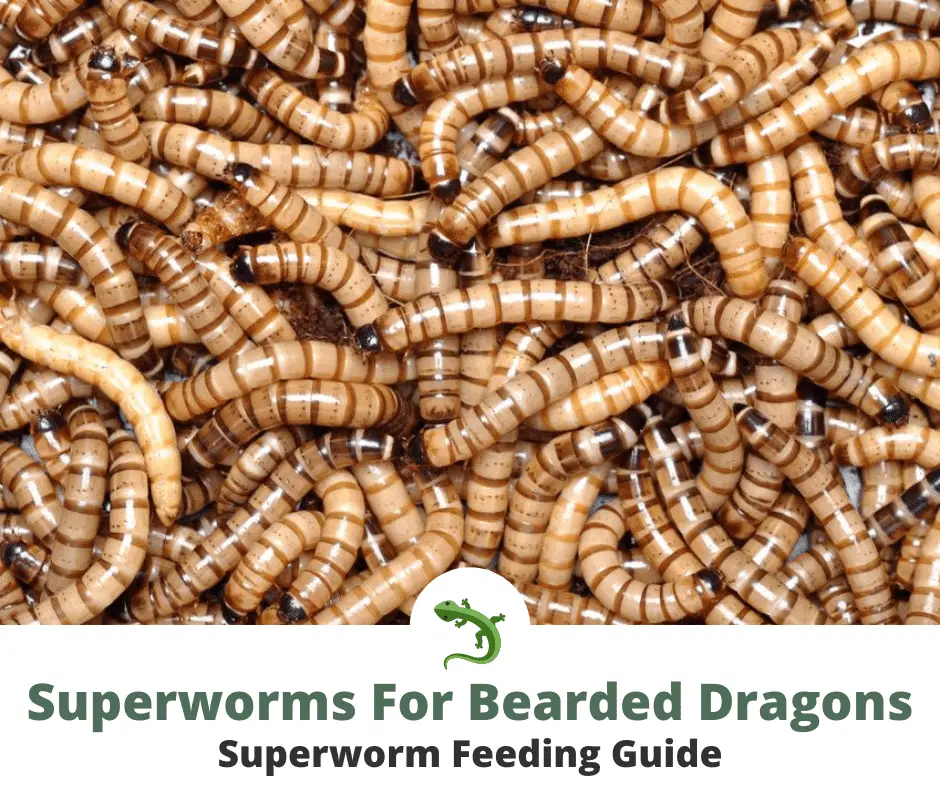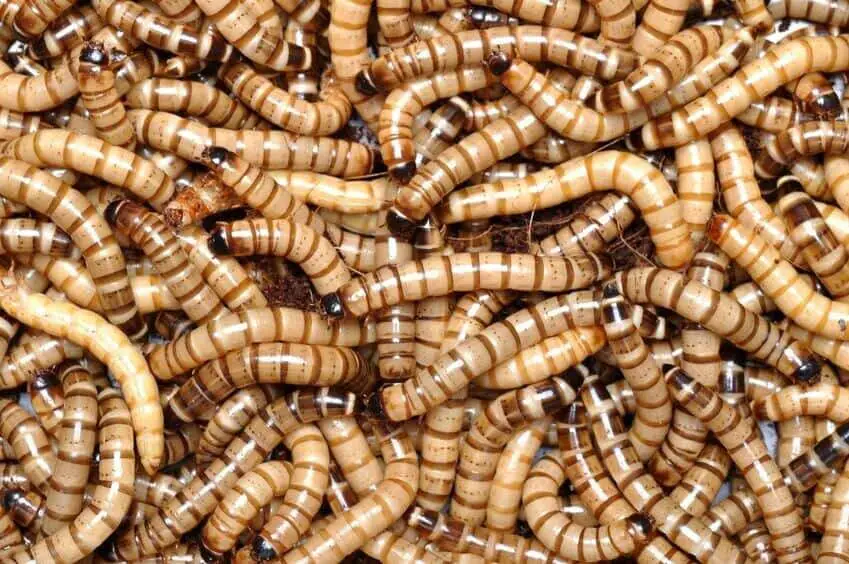Superworms are an excellent source of calcium, fat, and fiber for bearded dragons. They can be fed to bearded dragons once or twice a week, depending on the size of your beardie. Superworms are also easy to breed at home if you want to save money.
In this guide, you’ll learn:
- Are superworms good for bearded dragons?
- How many superworms should I feed my bearded dragon?
- Can superworms harm my bearded dragon?
- How can I breed my own superworms at home?

What Are Superworms?
Superworms are the larvae of a darkling beetle called Zophobas morio. They are sometimes called king worms, morio worms, or Zophobas. Superworms are widely available food for lizards, not to be confused with giant mealworms which are regular mealworms (Tenebrio molitor larvae) sprayed with a juvenile growth hormone. The name superworm is a misnomer since these are actually the larvae of insects and are not worms.

Can Bearded Dragons Eat Superworms?
Yes, bearded dragons can eat superworms but in moderation as a treat since these are high in fat. They can sometimes be fed more often to malnourished dragons to help them gain a bit of weight.
Are Superworms Good For Bearded Dragons?
Aside from being a nice treat, superworms are actually a good source of calcium, fat, and fiber. They have thicker “shells” or chitin so they can be tough to chew. They also tend to bite and have a pin-like structure on their backs they can use to attack so these are best reserved for adult or bigger dragons that can handle the tough shell and easily fend off bites.
Superworms are also more active than most worms so they are great if your dragon enjoys hunting their food. Their pleasant taste can also entice picky eaters to start eating other food such as veggies.
Elemental Analysis of superworms (from Fluker Farms):
Moisture 61.92%
Fat 14.19%
Protein 19.06%
Fiber 2.6%
Calcium 173 ppm
How Many Superworms Can I Feed My Bearded Dragon?
Since superworms are 14-15% fat (which is quite high), these are best given in moderation as part of a varied bearded dragon’s diet. Feed 1-2 superworms once or twice a week depending on the build and activity level of your adult dragon. If your dragon is getting a bit chunky, then you may have to lessen their treats.
Juvenile bearded dragons can have a bit more fat in their diets since they are still growing so they can be fed 3-5 small superworms per day but spaced out in 3 meals. However, make sure you only feed your dragon small superworms. Anything bigger than the space between your dragon’s eyes shouldn’t be fed to them since they might have trouble eating them.
Pro-tip
Feed your bearded dragon superworms after other insects or vegetables as a dessert especially as juveniles so they don’t get too used to the taste and start to become picky eaters.
Baby bearded dragons shouldn’t be fed superworms. Aside from being too small, their soft jaws may not be able to handle the tough shells or exterior of superworms leading to several digestion or impaction issues.
Remember to give your dragon a well balanced beardie diet since they are omnivores. Babies and juveniles should get a 70%-30% insect to greens ratio since they need more protein while adults should get a 30%-70% insect to greens ratio to help with better digestion as they age.
How to Feed Superworms to Your Bearded Dragon
Feed superworms to your bearded dragon just like you would any live insect. You can use tweezers and place them in their feeding bowl or place them a few inches away from your dragon so they can try and chase them.
It’s a bit hard to dust superworms because of their slick exoskeleton so you should gut load these insects with any nutritious cricket gut loading food or a calcium supplement 24 hours before feeding to your pet.
You can also use superworms to entice your dragon to eat greens. Place a live superworm on the greens to entice your dragon to eat them. If your dragon is still a juvenile, it’s best to feed the superworms after a nutritious meal (crickets or dubia roaches) as a treat so they don’t become too picky and prefer the high fat superworms as their food.
You may want to wear gloves while handling superworms or use tweezers as they tend to bite. You should also avoid placing superworms in loose substrate as these active worms can easily burrow into the substrate and can bother your beardie later on if you miss taking them out of their enclosure after feeding.
📚 Read More >> Best Enclosures For Bearded Dragons
Pro-tip
If your dragon is having a hard time with the tough shell of superworms, you can feed it the newly molted ones which are softer and easier to eat.
How to Keep Superworms for Bearded Dragons
Superworms are easy to keep as live feeder insects in a plastic bin with air holes at room temperature (65-80°F). Bins with ventilated lids work better so the humidity doesn’t build up and encourage mold growth. Don’t refrigerate superworms because they will die instead of going into hibernation.
Place some mealworm bedding, oatmeal, wheat middling, or dry bran as a bedding and source of food. Slices of carrots or potatoes can serve as a source of hydration if the bin gets too dry. If you notice severed heads that are dried up, your worms have begun eating each other for hydration.
If you plan on breeding superworms, you can separate the bigger, fatter, and well-fed worms in film canisters or a tackle box so you can force them to pupate (don’t forget to put air holes) with a bit of bran as bedding. When they start to curl up, they’re beginning to pupate. Otherwise, they may have died.
They remain in the pupae stage for about 3 months after which they become beetles. Separate beetles from your larvae because these insects are cannibalistic. Each beetle can lay hundreds of eggs.
Cheap Organizer For Breeding Superworms At Home
About Superworms
👍 Pros Of Superworms:
- Affordable and easy to breed
- Readily available in most pet stores
- A tasty treat for bearded dragons especially for picky eaters
- More active than other worms so they can be enjoyed in a hunt by most bearded dragons
- Good source of fat, calcium, and fiber for growing beardies
👎 Cons Of Superworms:
- High in fat content so feeding bearded dragons too much can lead to obesity and malnutrition
- Tend to bite so you have to be careful in handling them or leaving them in with small bearded dragons
- Bigger than most mealworms so you have to be careful if your dragon is not yet big enough to consume them
- Have a tough outer shell/exoskeleton which can be hard for some dragons to chew
Where To Buy Superworms For Bearded Dragons?
Superworms are widely available online and in most local pet stores or specialized reptile/exotic animal stores. They are affordable treats for your bearded dragon. Ask your veterinarian or your local breeder where you can securely buy superworms and other feeder insects that are well bred and free from parasites.
FAQs
How Many Superworms Should I Feed My Beardie Each Day?
Baby bearded dragons should not be fed superworms since these can be too big for them to eat and cause digestion issues. Juveniles can get 3-5 worms per day but spaced out in between meals. Adult dragons can have 1-2 superworms once or twice a week.
Remember, these insects are high in fat and should be given in moderation to your beardie. As juveniles, they can eat a bit more but feed these at the end of a more nutritious meal so that your dragon does not develop too much of a liking for the taste and start becoming picky. Adult beardies should only get them once in a while as treats to ward off obesity and malnutrition.
Do Superworms Bite Humans?
Yes, some superworms tend to be aggressive and bite so you should use tweezers or gloves while handling them. You can also hold them near the head to avoid being eaten or use a small cup to scoop them up for feeding.
Why Do My Superworms Keep Dying?
Excess moisture, heat, and extreme cold in their habitat are common causes of superworm die off. Superworms are also cannibalistic so if they don’t get fed well or feel dehydrated, they will eat other superworms!
Moisture can build up in their bin if you keep too many worms with poor ventilation. Signs of excess moisture are mold in the substrate or condensation along the walls of the bin.
Superworms can also overheat if they are overcrowded or if there’s too much substrate. Avoid placing your bin under direct sunlight since that can cause heat to build up inside. If you see worms that are overactive, curling, or flicking back and forth then they are probably overheating.
Superworms can also become inactive when kept too cold. They will die if refrigerated (39°F) or kept below 65°F for prolonged periods of time. If you notice your superworms burrowing into the substrate then it may be too cold for them. Really cold worms may appear dead but after warming up they can spring back to life. Keep your superworms in room temperature between 65-80°F to keep them healthy.
Are Superworms Dangerous To My Beardie?
Superworms are not dangerous to your bearded dragon. Larger, aggressive ones can be a nuisance to smaller bearded dragons since they tend to bite so just observe your beardie during feeding time and clear off any excess food after.
You should also pay attention to the size of the worms or any live insect you are feeding your dragon. Make sure they are not bigger than your dragon’s head or the space between its eyes.
Superworms can be dangerous to your beardie if you feed them too much since these are high in fat and can cause obesity and malnutrition.
There’s a myth that you should take out the head of superworms because they can bite through the stomach and intestines of your pet. This is not true since the gastric juices will kill your dragon’s food. If you are worried about this, there are alternative feeder insects you can use or just pay close attention to the size of the superworms you are feeding your bearded dragon.
Conclusion
Superworms are a good treat for adult bearded dragons and juveniles but should not be part of their staple diet because of their high fat content. These are tasty worms that most bearded dragons love. They are also affordable, widely available, and easy to care for if you want to start breeding them. However, they can bite so make sure you choose smaller ones to feed your dragon and clear them out after feeding.
Further Reading
Superworm breeding and care guide:
Super Worms – Zophobas moria
Caring for Live Superworms – Keep your superworms alive! – Ovipost
Breeding Superworms: A guide to raising and breeding superworms – Gecko Time
Introduction to bearded dragons:
Bearded dragons: facts and photos
An article tackling some feeding myths found online:
Fact Vs. Fiction on food for herbivorous reptiles
Comprehensive bearded dragon care sheet you can print (PDF):
Care Sheet – Bearded Dragon
A full and exhaustive guide to bearded dragons from taxonomy, history, behavior, breeding, and many more:
Husbandry Manual For Bearded Dragons. Reptilia: Agamidae




